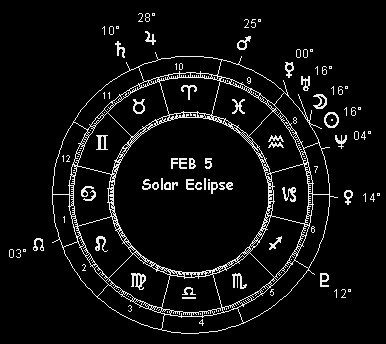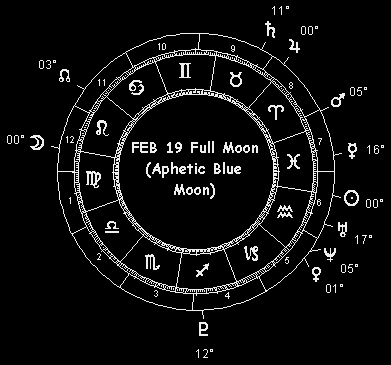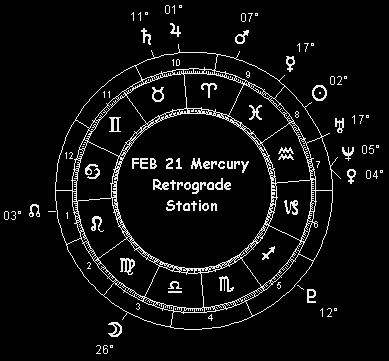If you were expecting some kind of sun sign nonsense, forget it. This is real astrology. See the section above. Please note: this forecast is expressed in terms of Universal Time (UT). Current UT date and time appear at the top of this page. (To update display, use your browser's reload/refresh button.)
PARTIAL ECLIPSE OF THE SUN
 After all the major planet action last month, February is relatively quiet - especially once the hubbub subsides after the solar eclipse on the 5th. Aside from the usual couple of Sun-Moon alignments and handful of significant moments in the lunar cycle, a Jupiter sign change and a Mercury retrograde are the major celestial markers to watch for this month.
After all the major planet action last month, February is relatively quiet - especially once the hubbub subsides after the solar eclipse on the 5th. Aside from the usual couple of Sun-Moon alignments and handful of significant moments in the lunar cycle, a Jupiter sign change and a Mercury retrograde are the major celestial markers to watch for this month.
It all starts off, of course, with the partial eclipse of the Sun on February 5. If you're a regular, you know what to expect from Sun-Earth-Moon alignments of this sort: an increased potential for strong storms and unusual flooding (inland due to heavy rain, coastal due to high tides either alone or in combination with windstorms and heavy rain); also a higher than normal risk for moderate to severe seismic activity, including Richter 5 or greater quakes as well as volcanic eruptions. These are times to avoid travel if possible, or at least to allow for weather-related delays. At home, make sure your emergency supplies are ample - just in case Mother Nature draws a bead on your house. You can also figure that people tend to be more emotionally charged than usual at times like this: either be ready to deal with it, or else steer clear of it altogether.
As noted in my January forecast - which incidentally contains a typo misidentifying this alignment as a SuperMoon (it's not, sorry) - the February 5 eclipse first began making waves starting on January 29. Because it's a solar eclipse, this one remains in effect through February 12. Strongest points during this particular geocosmic shock window come within plus or minus 30 hours of the Moon reaching maximum south declination on the 2nd, as well as Luna's equatorial crossing on the 9th. Being planetary in scale, alignments of this sort can be accompanied by seismic and meteorological cataclysms virtually anywhere on Earth. However the astro-locality map for the February 5 partial solar eclipse focuses on east Africa and the western British Isles, the US Midwest and eastern Canada, New Zealand and the far eastern stretches of Russia; and along a northwesterly arc from west India through Pakistan, across Russia over to Scandinavia. (As I said in my 2000 Forecast Highlights published last year - and as the headlines have demonstrated since January 29 when this eclipse window opened - "watch for this one to wreak havoc with power and communications infrastructure.")
There's more to this solar eclipse than meteorological and seismic extremes. It comes within days of the US Federal Open Market Committee meeting, and just over a week before Jupiter enters Taurus. I've already described a combination of factors in effect during this period - see my January forecast - as making "a Fed hike look very likely in February." Jupiter's Taurus ingress just adds fuel to the fire: the seeds of inflation that sprouted under Jupiter's exploratory Taurus transit (June to October 1999) will soon be growing like weeds. This is great for commodity investors, not so hot for those holding speculative equities. If you didn't take last month's advice to short "highly speculative, liquidity-driven stocks from companies that can't turn a profit" - and particularly "the Internet high-fliers (that) are apt to take a beating for a while" - February may yet offer a few opportunities for such moves. Otherwise, financials and commodities are the strong suits by and large, although reasonably valued blue chips in other sectors will also present some decent buying opportunities.
MORE GEOCOSMIC SHOCK WINDOWS
 The next storm and seismic risk window worth watching extends from late on the 14th to late on the 23rd, although it's not in the same league as an eclipse or a SuperMoon. The onset of this particular period of vulnerability is signaled by the Moon reaching maximum declination north of the equator early on the 16th. The Moon reaches perigee - closest approach to Earth - the very next day. Each of these celestial factors has in the past been a timer (plus or minus 30 hours) for strong storms and moderate to severe seismic activity (e.g. Richter 5+ quakes, volcanic eruptions). Throughout most of this whole period - from the 16th through the 22nd, at any rate - the February 19 Full Moon is stirring things up as well. This just happens to be an Aphetic Blue Moon, incidentally: the first in a pair of consecutive full moons to occur in the same sign. Then, just as the full moon effect is winding down, comes the Moon's southward crossing of the celestial equator on the 22nd. This extends the storm and seismic risk factor to the 23rd, when it finally subsides for nearly a week.
The next storm and seismic risk window worth watching extends from late on the 14th to late on the 23rd, although it's not in the same league as an eclipse or a SuperMoon. The onset of this particular period of vulnerability is signaled by the Moon reaching maximum declination north of the equator early on the 16th. The Moon reaches perigee - closest approach to Earth - the very next day. Each of these celestial factors has in the past been a timer (plus or minus 30 hours) for strong storms and moderate to severe seismic activity (e.g. Richter 5+ quakes, volcanic eruptions). Throughout most of this whole period - from the 16th through the 22nd, at any rate - the February 19 Full Moon is stirring things up as well. This just happens to be an Aphetic Blue Moon, incidentally: the first in a pair of consecutive full moons to occur in the same sign. Then, just as the full moon effect is winding down, comes the Moon's southward crossing of the celestial equator on the 22nd. This extends the storm and seismic risk factor to the 23rd, when it finally subsides for nearly a week.
The month ends with the Moon reaching maximum declination south of the equator on the 29th, the harbinger of a storm and seismic risk window that extends from the 28th on into March 1.
MERCURY GRINDS GEARS
 The heliocentric Saturn-Uranus square that was exact on January 29, 2000 remains very much in effect all this month as well. It doesn't exceed five degrees of partile (exact) aspect until mid-August, in fact. So the breakdowns in high-technology infrastructure (principally computers and communication) as well as criminal assaults on that infrastructure that were so much in the news last month will still be very much in evidence throughout February: cyberterror, computer viruses and hacker attacks, the whole nine yards.
The heliocentric Saturn-Uranus square that was exact on January 29, 2000 remains very much in effect all this month as well. It doesn't exceed five degrees of partile (exact) aspect until mid-August, in fact. So the breakdowns in high-technology infrastructure (principally computers and communication) as well as criminal assaults on that infrastructure that were so much in the news last month will still be very much in evidence throughout February: cyberterror, computer viruses and hacker attacks, the whole nine yards.
The pace of such intentional chaos - not to mention the comedy of errors resulting from short-sightedness and the law of unintended consequences - will surely intensify after the 21st, when Mercury's retrograde ushers in three weeks of Murphy's Law running the show anyway. Relax, this retrograde ends March 14: use the time until then to double-check everything, to fix what goes wrong (lots of opportunities for that), to do follow-ups on initiatives that fell flat earlier in the month. Above all, have a Plan B ready . . . and a Plan C, and a Plan D, etc. Speaking of plans, plan on everything taking longer than it should, expect that people won't get it right the first time.
Strikes in the health care and entertainment sectors as well as oil supply disruptions and significant shipping delays are among the key screw-ups I see as likely during this particular retrograde. Somebody's asleep at the switch, makes a bonehead miscalculation, etc.
 SPECIAL FEATURE: This month's birthdays of the famous and infamous (with astrological birth charts)
SPECIAL FEATURE: This month's birthdays of the famous and infamous (with astrological birth charts)